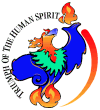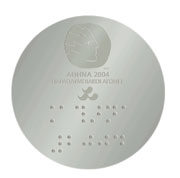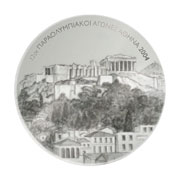Tandem racing at the 2004 Paralympic Games
Read and learn about how 2004 Athens Paralympic Games medals are designed
The 2004 Paralympic Games Mascot - Proteas
Paralympic Firsts will take place in Athens
United States Association of Blind Athletes
Difference between the Paralympics and the Special Olympics
The
Paralympic Games are the second largest sporting event in the world,
The Paralympic Games are run under the auspices of the International Paralympic Committee. The U.S. Olympic Committee and the U.S. Paralympics oversees the USA Paralympic Team by selecting the elite athletes for international competition while delegating authority to various disabled sports organizations. The United States will have approximately 300 delegates in Athens, Greece.
History of the Paralympic Games
Sir Ludwig Guttman, the “father” of sport for people with a disability, created the Paralympic Games. While working with ex-servicemen at the Stoke Mandeville Hospital after World War II, Guttman recognized the need for competition and staged the 1948 International Wheelchair Games to coincide with the 1948 London Olympic Games. The event grew gradually encompassing other sports and other disability categories.
In 1960 the first Paralympic Games were held in Rome, Italy and consisted largely of disabled war veterans with physical disabilities, and in particular, for persons with a spinal cord injury. Four hundred athletes form 23 countries competed in a limited selection of events.
The Vth
International Games, organized in 1976, included other disabilities: blind
and amputees. In 1980, in Arnhem, the Netherlands, athletes with cerebral
palsy joined the Games. Since that time, the Games have been held every four years to
coincide with the Olympic Games.
Since 1988, the Paralympics have been conducted in the same venues as the Olympics, just after the Olympic games close.
|
Year |
City |
Participants |
|
|---|---|---|---|
| 1960 | I. | Rome, Italy | 400 athletes from 23 countries |
| 1964 | II. | Tokyo, Japan | 390 athletes from 22 countries |
| 1968 | III. | Tel Aviv, Israel | 750 athletes from 29 countries |
| 1972 | IV. | Heidelberg, Germany | 1000 athletes from 44 countries |
| 1976 | V. | Toronto, Canada | 1600 athletes from 42 countries |
| 1980 | VI. | Arnhem, Netherlands | 2500 athletes from 42 countries |
| 1984 | VII. | Stoke
Mandeville, UK New York, USA |
4080 athletes from 42 countries |
| 1988 | VIII. | Seoul, Korea | 3053 athletes from 61 countries |
| 1992 | IX. | Barcelona, Spain | 3020 athletes from 82 countries |
| 1996 | X. | Atlanta, USA | 3195 athletes from 103 countries |
| 2000 | XI. | Sydney, Australia | 3843 athletes from 123 countries |
 |

Blaze, 1996 Paralympic Mascot |
 |

Lizzie, 2000 Paralympic Mascot |
Tandem racing at the 2004 Paralympic Games (Paralympic Race Schedule)
Since the international governing body for the sport of cycling (the UCI) removed tandem cycling from its world championships in 1994, the Paralympics have become the premier world-class international competition opportunity for tandem cyclists. Elite sighted road and track cyclists may pursue this path toward a world championship in tandem cycling by teaming up with a blind athlete.
The Paralympic Games Cycling programme includes two disciplines: Road Cycling and Track Cycling. Road Cycling races take place on public highways, while the Track Cycling races take place on tracks, or in other words, a velodrome. Although the rules and regulations governing the sport are the same as those for the Olympic Cycling, in certain cases modifications to the bicycles are allowed in order to facilitate athletes with specific disabilities.
Athletes with partial or total vision impairment, celebral palsy, spinal cord injuries, amputees or any other permanent physical deficiency can participate in Cycling. The athletes are classified into categories based on their functional abilities together with the skills required for the sport. The athletes’ bicycles are modified, whenever considered necessary, according to the athletes’ needs.
Track Cycling events will be held in the Olympic Velodrome at the Athens Olympic Sports Complex (OAKA), within five competition days, September 18-22, 2004. Road Cycling events will be held in Vouliagmeni, within the span of three competition days, from September 24-26, 2004.
Read and learn about how 2004 Athens Paralympic Games medals are designed
The Paralympic Games medals are one of the most important design applications, since the medals is given to the athletes, the real protagonists and heroes of the Paralympic Games as a reward for their achievements.
 |
The mascot creator searched for an image that would portray the four unique values for the ATHENS 2004 Paralympic Games: inspiration, strength, pursuit, celebration. At the same time, the creator wanted the mascot to express the unique flavour that hosting the Paralympic Games in Greece would bring to the event. |
The creator found what he was looking for in the image of the sea. The sea has been a core element of Hellenic culture, its representations embracing a huge variety of applications and connotations, from peace and tranquility to passion and strength. The sea element has provided the Greek mythology with numerous gods and characters, as well as a series of heroes who have managed to overcome human limitations and offer thrilling moments and narrations with their achievements.
The mascot for the 2004 Paralympic Games is a sea – horse (hippocampus) named Proteas, from a divinity of the Greek mythology. The name embraces the notion of excellence that is a core notion of the Paralympic Games, as the athletes seek to overcome themselves in achieving even higher competition performances. The Greek word “protos” means first in rank, excellent.
Please welcome Proteas, the mascot for the ATHENS 2004 Paralympic Games. Proteas will be an ideal ambassador of the Athens Paralympic Games around the world and will inspire everyone to take part in this elite sport event, hosted for the very first time in Athens in September 2004.
Common visual elements between Paralympic and Olympic mascots. Proteas presents the following common visual elements with Phivos and Athena, the Olympic Games mascots:
| The same fine lines apply to all three mascots’ design: | |
| Their names are written using the same typography, which has been designed especially for the mascot names | |
| They all bear the ATHENS 2004 brand names and the distinctive elements of the event they promote (IOC emblem for the Olympic Games, IPC emblem for the Paralympic Games) | |
| Their names have been inspired from Greek
mythology and heritage
|
|
|
Paralympic Firsts will take place in Athens For the first time, the Olympic and Paralympic summer Games will be organised by a single Organising Committee after the signing of the IOC – IPC Cooperation Agreement. · It is the first time women will compete in Judo in the Paralympic Games. · For the first time Football 5-a-side will be contested at the Paralympic Games. · It is the first time that women teams will compete in Volleyball (Sitting). · Handcycling will take place for the first time at the ATHENS 2004 Paralympic Games Referenced from: http://www.athens2004.com/en/ParalympicFirsts/paralympicfirsts 20004 Athens Paralympic Games - Facts & Figures
The U.S. Olympic Committee is a
non-profit tax-exempt organization based in Colorado Springs, Colo. The
USOC works with more than 50 member organizations to provide programs
and services to develop athletes and coaches that one day dream of
participating in the Olympic, Paralympic and Pan Am Games and to promote
the Olympic and Paralympic ideals throughout the United States. The disabled sports organizations foster development
opportunities. The five disabled sports organizations (dso's) in the United States
are the United States Association of Blind
Athletes (USABA), United States Cerebral Palsy Athletic Association
(USCPAA), Disabled Sports USA (DSUSA), U.S. Wheelchair Athletic
Association (WSUSA), and Dwarf Athletic Association of America (DAAA) |
United States Association of Blind Athletes (USABA)
United
States Association of Blind Athletes (USABA) offers
athletic opportunities to individuals who are blind and visually impaired.
There are three visual classifications set forth by the International Blind Sports Association:
B1 Athlete (totally blind, no
more than light perception)
B2 Athlete (best vision is
20/600)
B3 Athlete (best vision is
20/200)
Ask
the average person what it means to be blind, they might clap their hands
over their eyes, not being able to see anything. Only about ten percent of
the legally blind population is actually completely blind. Most legally blind people have
some degree of functional vision.
Matt fits into the vision classification B1, to put Matt's visual acuity in lay terms, he can see no more than light perception. Matt was born blinded by retinitis pigmentosa (RP), an inherited incurable eye disease that gradually destroys the retina and optic nerve.
Difference between Special Olympics and Paralympics
Many people confuse the Special Olympics and the Paralympics, although the two are separate events with very different objectives. The Special Olympics provides an opportunity for athletes with mental and cognitive impairments to compete in an event whose focus is on participation. Everyone is welcome to take part and all are considered winners and receive prizes. Paralympic athletes are elite competitors who must qualify for their competitions along similar guidelines as their Olympic counterparts. Medals are awarded only to the winners.


